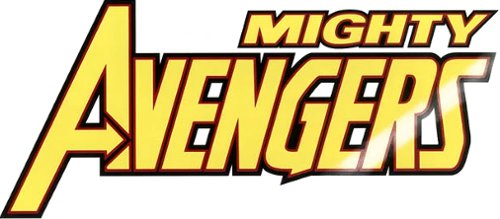BIOGRAPHY - Page 11
This page deals with the divergent version of Kang-Prime who chose to reject his destiny of becoming Immortus and become KANG again instead.
As he passed into Limbo, the resigned Rama-Tut experienced the flood of timeless imagery most beings experience on the outskirts of the realm. Among the various images of his past, however, he also saw a piece of his future: Immortus, agreeing to be a servant to the Time Keepers. Repulsed by the idea of giving up conquest AND no longer being his own master, Rama-Tut refused his destiny once more. In that instant, he rededicated himself to preventing his life from 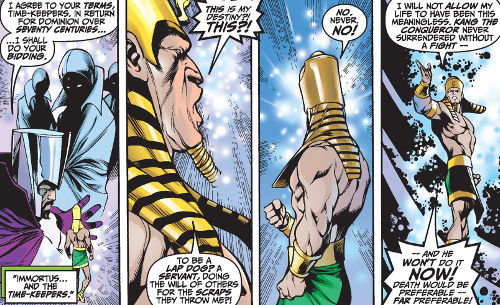 becoming that of Immortus. Rama-Tut reassumed the role of Kang the Conqueror, flush with the discovery of a new foe to war against: fate itself. He returned to Chronopolis and in the span of hours wiped out nearly all of his rivals for control of temporal territory by setting them against each other. With the field of battle cleared of all but him and Immortus, Kang began to campaign anew. He also destroyed the body-jump mechanism which had saved him so many times in the past, declaring there would be no more cheating death or fate -- he would approach them straight on and spit in their eyes. Kang found unlikely allies in Libra of Zodiac and the Kree Supreme Intelligence and prepared for war in final defiance of his own future. [Avengers Forever #9]
becoming that of Immortus. Rama-Tut reassumed the role of Kang the Conqueror, flush with the discovery of a new foe to war against: fate itself. He returned to Chronopolis and in the span of hours wiped out nearly all of his rivals for control of temporal territory by setting them against each other. With the field of battle cleared of all but him and Immortus, Kang began to campaign anew. He also destroyed the body-jump mechanism which had saved him so many times in the past, declaring there would be no more cheating death or fate -- he would approach them straight on and spit in their eyes. Kang found unlikely allies in Libra of Zodiac and the Kree Supreme Intelligence and prepared for war in final defiance of his own future. [Avengers Forever #9]
When Immortus made his move against Rick Jones, Kang was prepared. He transited to Earth's moon in a time bubble that neutralized the temporal freeze effect Immortus created for his 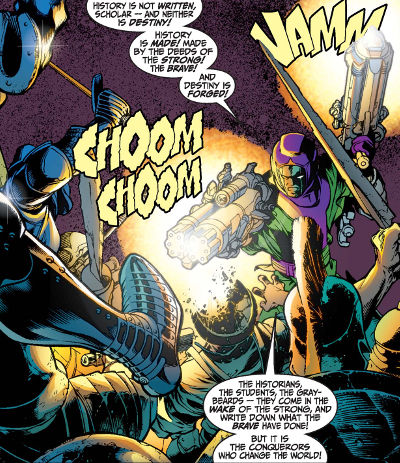 assassin Tempus to carry out Jones's execution. Kang destroyed Tempus, but was forced to confront an army of the ages assembled by Immortus to complete the execution. Kang held his ground as one man against the soldiers of every era until Libra managed to coax the Destiny Force from Rick's mind, summoning a cross-time team of Avengers in Rick's defense. Immortus was forced into a temporary retreat while Kang and Libra brought the Avengers up to date on the matters at hand. Because Jones was Immortus' prize, Kang instructed the Avengers to keep the boy outside of time's flow where Immortus couldn't locate him, while Kang dealt with his counterpart directly. [Avengers Forever #1-2]
assassin Tempus to carry out Jones's execution. Kang destroyed Tempus, but was forced to confront an army of the ages assembled by Immortus to complete the execution. Kang held his ground as one man against the soldiers of every era until Libra managed to coax the Destiny Force from Rick's mind, summoning a cross-time team of Avengers in Rick's defense. Immortus was forced into a temporary retreat while Kang and Libra brought the Avengers up to date on the matters at hand. Because Jones was Immortus' prize, Kang instructed the Avengers to keep the boy outside of time's flow where Immortus couldn't locate him, while Kang dealt with his counterpart directly. [Avengers Forever #1-2]
As Kang anticipated, Immortus soon brought the fight to him. Chronopolis came under siege by an endless army of warriors and armaments assembled at Immortus' whim. In the blitz that followed, Ravonna was apparently killed along with most of Kang's Anachronauts. Kang retreated to his citadel and, as he prepared for the next wave, greeted the arriving Avengers when they refused to 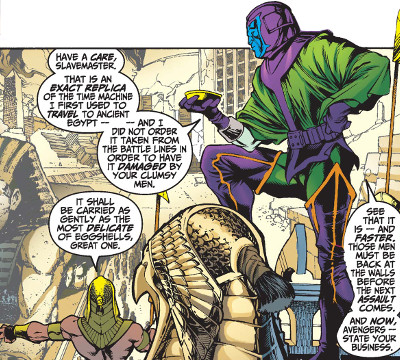 remain outside of time. Kang welcomed the valor of his greatest foes to stand beside him in this final conflict. And final it was. Despite his skills as a general, Kang was unable to stop the endless hordes Immortus directed at his kingdom. When it became clear the end was nigh, Kang provided a time-ship to the Avengers so that they could escape. He remained behind to battle Tempus again, but failed to stop Immortus from claiming the Heart of Forever as his own. Immortus used his time-magicks to collapse everything in Chronopolis into the Heart, drawing upon the essence of so many time-travelers and temporally-displaced objects, allowing him to reshape the Heart of Forever into his new talisman, the Forever Crystal. [Avengers Forever #3]
remain outside of time. Kang welcomed the valor of his greatest foes to stand beside him in this final conflict. And final it was. Despite his skills as a general, Kang was unable to stop the endless hordes Immortus directed at his kingdom. When it became clear the end was nigh, Kang provided a time-ship to the Avengers so that they could escape. He remained behind to battle Tempus again, but failed to stop Immortus from claiming the Heart of Forever as his own. Immortus used his time-magicks to collapse everything in Chronopolis into the Heart, drawing upon the essence of so many time-travelers and temporally-displaced objects, allowing him to reshape the Heart of Forever into his new talisman, the Forever Crystal. [Avengers Forever #3]
Badly beaten, Kang retreated to an isolated safehouse he once constructed in the realm of Purgatory. Although weary from his losses and the crushing approach of destiny, Kang resolved to fight on regardless. He was contacted by Rick Jones and the Supreme Intelligence, who alerted him that the Avengers had confronted Immortus in Limbo and fallen to his power. Seeing an opportunity for one last valiant stand, Kang rallied his allies to confront Immortus and the Time Keepers for the end game. [Avengers Forever #9]
Locating the Avengers in the 31st century, Kang arrived as the Time Keepers declared the majority of timelines must be destroyed in order to cull the threat humanity posed to them. They fled from Kang's arrival, taking with them Immortus and the Forever Crystal. With the Avengers by his side, Kang traced the Keepers to their Citadel at the End of Time, where they intended to use the Crystal to power their Chronos Cannon and wipe away the threatening timelines. As Kang and 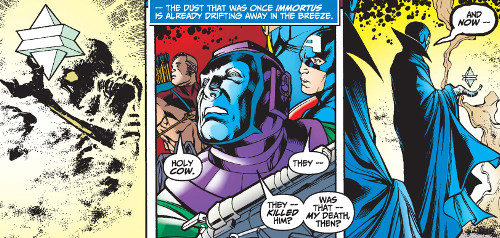 the Avengers attempted to breach the Keepers' schismatic barrier, however, Immortus finally stood up to his employers, pleading that humanity must be given another chance. Unwilling to waste any further time, the Time Keepers executed Immortus on the spot, reducing him to ash and taking the Forever Crystal. Kang was forced to watch from outside the barrier as his own death happened before his eyes.
the Avengers attempted to breach the Keepers' schismatic barrier, however, Immortus finally stood up to his employers, pleading that humanity must be given another chance. Unwilling to waste any further time, the Time Keepers executed Immortus on the spot, reducing him to ash and taking the Forever Crystal. Kang was forced to watch from outside the barrier as his own death happened before his eyes.
The battle escalated dramatically, as the Time Keepers summoned the fallen and corrupted Avengers from every timeline where the team went wrong. Through the power of the Destiny Force, Rick Jones summoned his own legion of heroic Avengers, and soon two armies of Destiny-enhanced Avengers began fighting throughout the Citadel. Kang remained a thorn in the Time Keepers' side, and so they attempted to remove him by forcibly evolving him towards his destiny, recreating their loyal servant Immortus from the start of his timeline. Kang fought back, resisting his destiny harder than he ever had before. The Conqueror of ages pitted his will against the 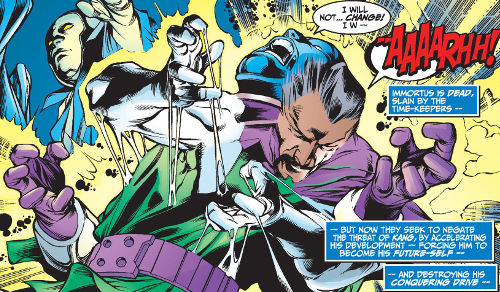 inevitable and, ultimately, it was the inevitable that blinked first. Kang literally cast off his presumed fate, the aspect of him that would become Immortus splitting off to become a separate and independent being. The Avengers' defeat of the Time Keepers and destruction of the Forever Crystal was a sideshow to Kang after this triumph. Confident that his destiny was now his own to chart, Kang executed the Time Keepers and escaped into the timestream before the Avengers could stop him, ready to plan new conquests. [Avengers Forever #10-12]
inevitable and, ultimately, it was the inevitable that blinked first. Kang literally cast off his presumed fate, the aspect of him that would become Immortus splitting off to become a separate and independent being. The Avengers' defeat of the Time Keepers and destruction of the Forever Crystal was a sideshow to Kang after this triumph. Confident that his destiny was now his own to chart, Kang executed the Time Keepers and escaped into the timestream before the Avengers could stop him, ready to plan new conquests. [Avengers Forever #10-12]
Newly satisfied that his future was his own to chart, Kang began to ponder his legacy. He desired an heir, a child equal to his own skills and brilliance, who could carry on his legend after he was 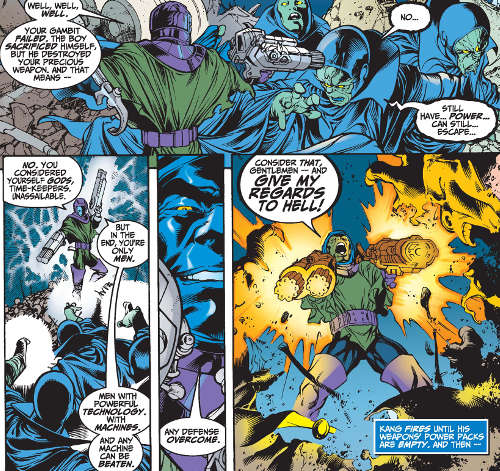 gone. And so, Kang assembled the finest "breeding stock" in his empire, searching for the perfect mate to conceive his son. This son, named Marcus, was sent twenty-five years into the past to be raised by tutors and trainers, skilled in all the arts of combat and warfare. Using time travel to visit the training world every fortnight from Marcus's perspective, Kang was able to rapidly monitor Marcus's development, as he reached adulthood in only a month from Kang's perspective.
gone. And so, Kang assembled the finest "breeding stock" in his empire, searching for the perfect mate to conceive his son. This son, named Marcus, was sent twenty-five years into the past to be raised by tutors and trainers, skilled in all the arts of combat and warfare. Using time travel to visit the training world every fortnight from Marcus's perspective, Kang was able to rapidly monitor Marcus's development, as he reached adulthood in only a month from Kang's perspective.
Despite his planning, however, Kang could not control everything. Marcus always developed a flaw somewhere in his apprenticeship: failure to learn a necessary skill, cowardice, sickness. Twenty-two times did Kang conceive an heir named Marcus, and twenty-two times he eliminated his son for being unfit of his name. It was Marcus the XXIII who finally seemed to be the perfect 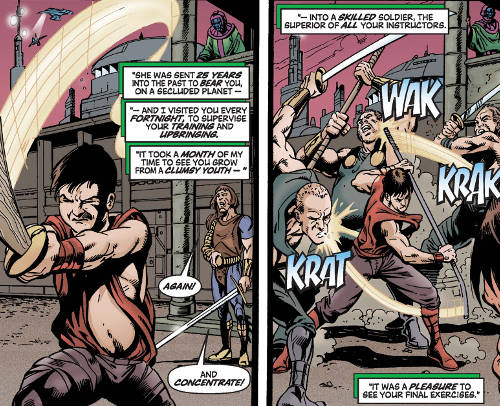 representation of Kang's ideals. Unaware of his previous "brothers," Marcus was dubbed the Scarlet Centurion and became Kang's right hand man, winning the respect of Kang's armies in battle and eager to conquer more of known space and time at his father's side. [Avengers (3rd series) #45, 54]
representation of Kang's ideals. Unaware of his previous "brothers," Marcus was dubbed the Scarlet Centurion and became Kang's right hand man, winning the respect of Kang's armies in battle and eager to conquer more of known space and time at his father's side. [Avengers (3rd series) #45, 54]
With his son in tandem, Kang prepared for the greatest conquest of his career, targeting 21st century Earth and the Avengers at the height of their power and membership. He brought Marcus back in time with him aboard their orbital Damocles Base, cloaked from detection. Kang had Marcus study the Avengers for weeks, learning to assess their weaknesses and respect their tenacity. Unknown to Marcus, Kang fully expected this to be his final campaign. He would be content to die on the battlefield if it meant securing his legacy and establishing Marcus as his heir apparent to carry on the empire. This conquest was to be the Scarlet Centurion's final test before ascending to the throne, one way or the other. [Avengers (3rd series) #38-40]
When the time was right, the Scarlet Centurion served as Kang's envoy, bringing his declaration of war before the United Nations. After a brief skirmish with the Avengers, Kang arrived and reined in 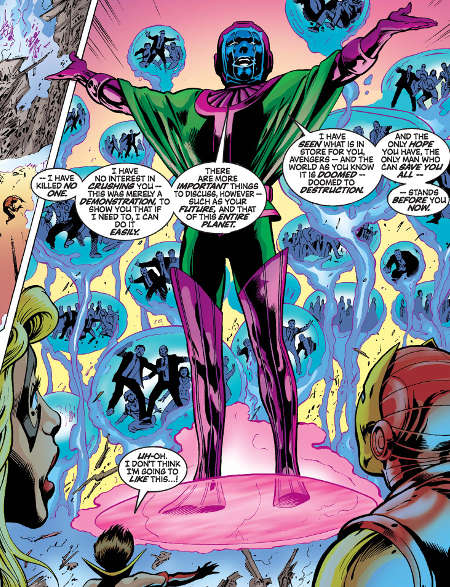 his son. He apologized for the conflict, for Marcus' mission was a peaceful one, but nevertheless felt the need to punish his foes for their hostility. Revealing the existence of Damocles Base hovering overhead, Kang called down a bolt of energy from orbit which destroyed the United Nations building. The people inside were preserved by Kang's force field technology, but it remained a dramatic show of force. [Avengers (3rd series) #41]
his son. He apologized for the conflict, for Marcus' mission was a peaceful one, but nevertheless felt the need to punish his foes for their hostility. Revealing the existence of Damocles Base hovering overhead, Kang called down a bolt of energy from orbit which destroyed the United Nations building. The people inside were preserved by Kang's force field technology, but it remained a dramatic show of force. [Avengers (3rd series) #41]
Kang addressed the Avengers and assembled dignitaries, explaining all the possible futures arising in the timestream from 21st century Earth, and the threats that would be faced. He styled himself as both conqueror and liberator, invading the modern world in order to save it from itself. Kang then set the terms for the war that would follow. Soon, he would begin his campaign to conquer Europe, a ground invasion he estimated would take no more than thirty-six days. In the meantime, he issued a call to arms around the globe, offering favoritism towards any local warlord or power-monger who seized territory in his name before his own armies got there. Finally, Kang promised to use conventional (if impressive) forces and tactics to conquer the planet, but only if the fighting remained localized on Earth. Any attempt to assault him directly in space at Damocles Base would result in an act of swift retribution using all the advanced technology at his disposal. Kang emphasized his point by allowing a strike against Damocles Base by the UN peacekeeping force, an orbital missile barrage that was harmlessly absorbed by the space station's force fields. [Avengers (3rd series) #42]
Sure enough, Kang's call to arms worked. The Avengers were soon occupied putting out fires on multiple continents as renegade Deviants, the Sharkan armies of Attuma, A.I.M., and other local forces destabilized the world trying to claim victories in Kang's name. The world fell into chaos  before Kang's forces ever fired their first shot. As Kang and Scarlet Centurion celebrated their early strategic success, Kang warned his son about his growing infatuation with the Avenger Warbird. Marcus had encountered Carol Danvers at the United Nations building and was impressed by her beauty and warrior spirit. Kang cautioned Marcus not to grow too attached to any woman, much less an enemy. The Scarlet Centurion seemed to heed his father's words, but Kang worried this was the first sign of weakness in Marcus XXIII. [Avengers (3rd series) #43-45]
before Kang's forces ever fired their first shot. As Kang and Scarlet Centurion celebrated their early strategic success, Kang warned his son about his growing infatuation with the Avenger Warbird. Marcus had encountered Carol Danvers at the United Nations building and was impressed by her beauty and warrior spirit. Kang cautioned Marcus not to grow too attached to any woman, much less an enemy. The Scarlet Centurion seemed to heed his father's words, but Kang worried this was the first sign of weakness in Marcus XXIII. [Avengers (3rd series) #43-45]
As Kang's armies landed in Europe and began marching across the continent, forces in the American government became increasingly impatient to end the threat of Kang. They were prepared to launch a flight of Sentinels at Damocles Base, despite Kang's warning of escalating retribution. When the Master of the World revealed a series of Plodex defense rings around major 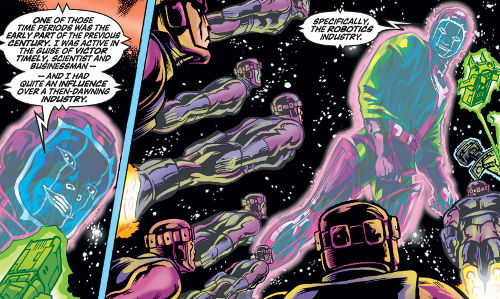 North American cities in defiance of Kang, the Avengers seized the opportunity to take the Master's resources for their own. Warbird led the mission, and so Marcus became directly involved in the situation, fighting alongside Warbird against the Master, ostensibly on behalf of his father. Warbird saved his life during the encounter, leaving Marcus in her debt. Even after he left Warbird to her mission and returned to Damocles Base, Marcus continued to aid the Avengers in their infiltration of the Master's base by remotely inhibiting his security sensors. [Avengers (3rd series) #46-48]
North American cities in defiance of Kang, the Avengers seized the opportunity to take the Master's resources for their own. Warbird led the mission, and so Marcus became directly involved in the situation, fighting alongside Warbird against the Master, ostensibly on behalf of his father. Warbird saved his life during the encounter, leaving Marcus in her debt. Even after he left Warbird to her mission and returned to Damocles Base, Marcus continued to aid the Avengers in their infiltration of the Master's base by remotely inhibiting his security sensors. [Avengers (3rd series) #46-48]
The Avengers were issued a deadline by the U.S. Armed Forces to resolve the crisis or else the military would intervene. They reluctantly led an attack on Damocles Base to defeat Kang, but were unable to penetrate his shielding. Indeed, their strike only fed Kang's armies. Kang still recalled his time as Victor Timely, ushering in the age of robotics at the start of the 20th century. As a result, he had installed a backdoor into all early robotic technology that carried over into subsequent generations, enabling him to seize control of the Sentinels with the flip of a switch. With the Avengers' fleet turned against them, Kang prepared for retaliation, guiding the Sentinels 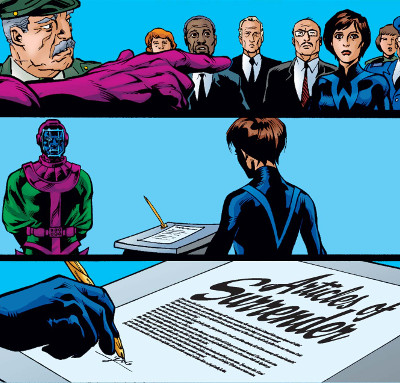 to Washington D.C. as a massive holographic avatar. Kang caused incredible chaos and destruction in the capital with his Sentinels before the remaining Avengers destroyed them. That did little to deter him, however. Kang's holo-avatar called down destructive fire from Damocles, and finally unleashed the future equivalent of a neutron bomb on Washington, killing nearly everyone in the city while leaving the buildings mostly intact. With their Sentinels destroyed, half the Avengers missing or presumed dead, and the President in hiding, the anti-invasion forces could not press on. Kang hosted a surrender treaty on a flying platform over the remains of Washington. Out of all the allied forces, Kang made sure that the Wasp, Chairwoman of the Avengers, was the first to sign. [Avengers (3rd series) #48-49]
to Washington D.C. as a massive holographic avatar. Kang caused incredible chaos and destruction in the capital with his Sentinels before the remaining Avengers destroyed them. That did little to deter him, however. Kang's holo-avatar called down destructive fire from Damocles, and finally unleashed the future equivalent of a neutron bomb on Washington, killing nearly everyone in the city while leaving the buildings mostly intact. With their Sentinels destroyed, half the Avengers missing or presumed dead, and the President in hiding, the anti-invasion forces could not press on. Kang hosted a surrender treaty on a flying platform over the remains of Washington. Out of all the allied forces, Kang made sure that the Wasp, Chairwoman of the Avengers, was the first to sign. [Avengers (3rd series) #48-49]
In the weeks that followed the surrender at Washington, Kang secured his rule of Earth. Several countries and rebel factions continued the fight against Kang's forces, but they had little effect. Conquered armies and super-heroes were held in prison camps until victory was final. The world was in his clutches. [Avengers (3rd series) #51]
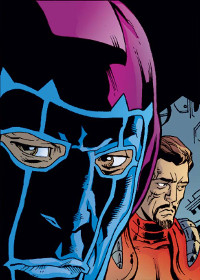 The free Avengers had not been idle, however. They freed their chairwoman and orchestrated a counter-response with various liberation forces. They had also spent the weeks since the occupation learning how to use the Master's organic Plodex technology to actively oppose Kang and Damocles Base. This was the one element Kang had not counted on -- he believed the Master would never work with the Avengers, keeping his foes at odds with each other, and the Master's security was sufficient to have prevented the Avengers from taking the Plodex bases by force. It was therefore Marcus who sealed this turn of events by helping Warbird and the Avengers escape detection by the Master, letting them get close enough to kill him and claim his bases. Kang knew of Marcus's indiscretions and offered the Scarlet Centurion several opportunities to admit his mistake, but Marcus never owned up to his actions.
The free Avengers had not been idle, however. They freed their chairwoman and orchestrated a counter-response with various liberation forces. They had also spent the weeks since the occupation learning how to use the Master's organic Plodex technology to actively oppose Kang and Damocles Base. This was the one element Kang had not counted on -- he believed the Master would never work with the Avengers, keeping his foes at odds with each other, and the Master's security was sufficient to have prevented the Avengers from taking the Plodex bases by force. It was therefore Marcus who sealed this turn of events by helping Warbird and the Avengers escape detection by the Master, letting them get close enough to kill him and claim his bases. Kang knew of Marcus's indiscretions and offered the Scarlet Centurion several opportunities to admit his mistake, but Marcus never owned up to his actions.
Damocles Base soon came under attack from a second front, as Captain America and the rest of the Avengers returned from space with the power of the Triune Understanding's Triple Evil under the command of Triathlon. Kang reassumed his massive energy avatar form, but Captain America was able to duplicate the feat using Triathlon's powers, leading to martial combat between the 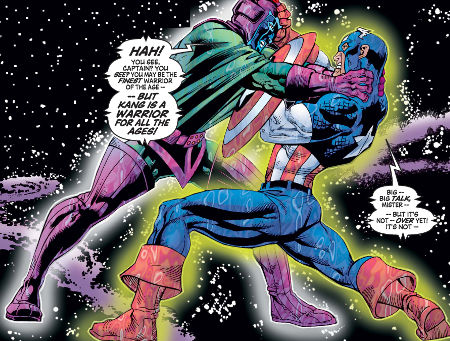 conqueror and the soldier across orbital space. Unfortunately, the two-pronged attack was more than Kang's forces could handle. The unexpected power of the Plodex weaponry combined with the Triple Power and the individual Avengers' attacks overloaded Damocles Base and its defenses. Kang shoved the Scarlet Centurion into an escape pod and announced his intent to go down with the ship. He said his legacy was complete, and it was time for Marcus to forge his own legend. Kang rode the burning orbital base down as it finally crashed to Earth. [Avengers (3rd series) #52-53]
conqueror and the soldier across orbital space. Unfortunately, the two-pronged attack was more than Kang's forces could handle. The unexpected power of the Plodex weaponry combined with the Triple Power and the individual Avengers' attacks overloaded Damocles Base and its defenses. Kang shoved the Scarlet Centurion into an escape pod and announced his intent to go down with the ship. He said his legacy was complete, and it was time for Marcus to forge his own legend. Kang rode the burning orbital base down as it finally crashed to Earth. [Avengers (3rd series) #52-53]
Battered and bruised, Kang crawled from the wreckage of Damocles Base after planetfall. His weapons and personal force field were exhausted of power keeping him alive from the impact, 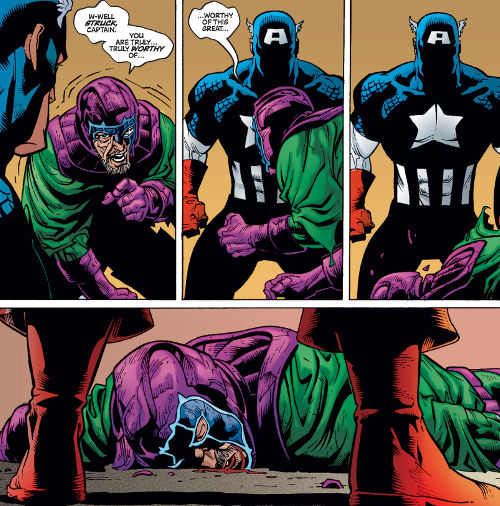 and he faced Captain America in final battle. Despite Kang's urgings, however, Cap refused to take his life at the end of the fight, and Kang was arrested and jailed for crimes against the world. Still, Kang was content. He was given an entire prison to himself, and treated with the respect a conqueror deserved by his captors. He would inevitably be tried, convicted and executed, but his legacy was secure. Marcus had betrayed him when it came to Warbird, but he was still a good heir to take the reins and carry on in his name.
and he faced Captain America in final battle. Despite Kang's urgings, however, Cap refused to take his life at the end of the fight, and Kang was arrested and jailed for crimes against the world. Still, Kang was content. He was given an entire prison to himself, and treated with the respect a conqueror deserved by his captors. He would inevitably be tried, convicted and executed, but his legacy was secure. Marcus had betrayed him when it came to Warbird, but he was still a good heir to take the reins and carry on in his name.
And then Marcus came to rescue him. Kang was furious at his son, and almost chose to remain in his cell and live out his days in confinement, but Marcus insisted on leaving with his father. Back in their extra-temporal quarters, Marcus was ecstatic at his father's return and gleefully looked forward to years of further conquests together, maybe even striking at 21st century Earth again. Instead, Kang told his son how wrong he was. Kang finally revealed to Marcus XXIII the truth that he wasn't Kang's first attempt at an heir, but up until now he had been the best. He laid out the failures of Marcus' brothers while admitting the invasion of modern Earth was always a gift, or final test, to Marcus, not a real shot at conquest. He revealed that he knew of Marcus' indiscretion with Warbird and the Master, and how it ultimately led to their defeat. He told Marcus he could have forgiven him if he admitted his mistake when given the chance, but Marcus never did. And he said 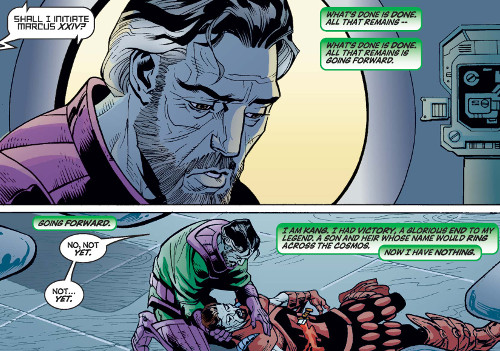 he even would have been content in prison with Marcus in control of his empire, for many celebrated conquerors began by betraying their fathers. But now Kang was back... and Kang could suffer no traitors in his midst. Kang killed his latest son with a dagger in the chest, and painfully watched as his dreams of legacy died with Marcus XXIII. When a computer prompted him if it should begin with Marcus XXIV, Kang said no... for he could not bear to try again this soon. [Avengers (3rd series) #54]
he even would have been content in prison with Marcus in control of his empire, for many celebrated conquerors began by betraying their fathers. But now Kang was back... and Kang could suffer no traitors in his midst. Kang killed his latest son with a dagger in the chest, and painfully watched as his dreams of legacy died with Marcus XXIII. When a computer prompted him if it should begin with Marcus XXIV, Kang said no... for he could not bear to try again this soon. [Avengers (3rd series) #54]
Perhaps feelings nostalgic, Kang next turned his attentions towards personal setbacks in his own life. He recalled the time when he was a teenager and was seriously hurt by some bullies at school. Seeking petty revenge, Kang traveled back in time and met his younger self just before his 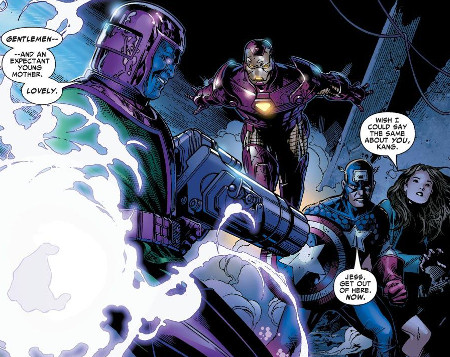 throat was slit by a razor-edged hoverboard. Freezing relative time, Kang offered young Nathaniel the chance to get back at his attacker, Morgan. Instead, the still innocent and idealistic Nathaniel stole Kang's armor and traveled back in time, hoping to find the Avengers and prevent his own future. [Young Avengers (1st series) #2]
throat was slit by a razor-edged hoverboard. Freezing relative time, Kang offered young Nathaniel the chance to get back at his attacker, Morgan. Instead, the still innocent and idealistic Nathaniel stole Kang's armor and traveled back in time, hoping to find the Avengers and prevent his own future. [Young Avengers (1st series) #2]
Kang eventually recovered and tracked his teenage self down to the Heroic Age. Nathaniel had become Iron Lad, assembling a team of Young Avengers to defend him against Kang's arrival. Iron Man, Captain America and Jessica Jones were also present at the time, and Kang did himself no favors by threatening to kill the pregnant Jessica if the Avengers didn't turn Iron Lad over to him. Still, Kang seemed to have a point about preserving the timeline, as New York City began to shift and change around the Avengers as a result of Iron Lad breaking the chains of causality by avoiding his future. Cap and Iron Man's costumes changed, and Jessica's pregnancy even vanished.
The Avengers agreed with Kang that Iron Lad needed to return to face his destiny. Time became more unstable the longer the two versions of Kang occupied the same space, and he prepared to send his younger self home, bereft of his recent memories. Instead, the Young Avengers fought 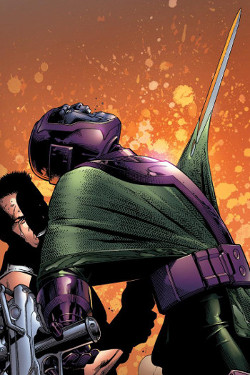 back against Kang and the Avengers to keep Iron Lad from having to do anything he didn't want to do. Sides shifted as Kang betrayed the Avengers and Iron Lad began to recognize the consequences of his actions, but Kang's treachery soon set all the heroes against him. Kang murdered the older Avengers present, and then set his sights on the Young Avengers. In the heat of battle, Iron Lad got the drop on Kang and plunged a sword into his back, killing him.
back against Kang and the Avengers to keep Iron Lad from having to do anything he didn't want to do. Sides shifted as Kang betrayed the Avengers and Iron Lad began to recognize the consequences of his actions, but Kang's treachery soon set all the heroes against him. Kang murdered the older Avengers present, and then set his sights on the Young Avengers. In the heat of battle, Iron Lad got the drop on Kang and plunged a sword into his back, killing him.
Oddly enough, reality did not end there. Still, Iron Lad's efforts to avoid his future began to cement the present, causing even some of the Young Avengers to fade from existence. This finally convinced Iron Lad to return to the future as he was meant to do. Once he stepped through the time portal, reality altered once again, apparently erasing everything that happened after Kang first arrived, including his death it seemed. [Young Avengers (1st series) #4-6]
[Note: Future encounters would show that Iron Lad did not travel directly back to the future as he was supposed, but it was seemingly enough to restore the present and undo Kang's demise. What other changes it may have caused in Kang's personal timeline, however, have yet to be explored.]
Kang started to become a magnet for time paradoxes, resurfacing time and again when the timestream was threatened by his actions or the actions of others. The conqueror was becoming the custodian yet again. When Adam Warlock grafted an orphan timeline onto the present in order to preserve the future, he restored the Magus timeline where Adam became the malevolent messiah of the Universal Church of Truth. The Church's influence threatened all non-believers across the timelines, including Kang. Kang pulled Star-Lord and several members of the Guardians of the Galaxy into Limbo to explain the situation, then armed them with a Cosmic Cube to return to the moment of the timeline's creation and prevent Adam's rise as the Magus. [Guardians of the Galaxy (2nd series) #19]
On another occasion, Kang was the source of a time paradox instead of the potential cure. Decades in the future of the Heroic Age, Ultron finally achieved the peak of his power and influence, conquering the globe and killing most of the Avengers and heroes, leaving only a small 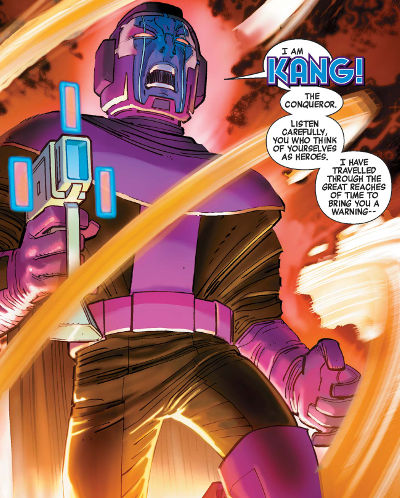 group of the next generation of Avengers (and their mentors) to oppose him. Kang saw an opportunity for glorious conquest and confronted Ultron at this time period. And failed. Charting his mistakes, Kang traveled back in time to attack Ultron again, erasing the events of his previous attack with a new strike so that Ultron couldn't learn from their last encounter as he did. And again he failed.
group of the next generation of Avengers (and their mentors) to oppose him. Kang saw an opportunity for glorious conquest and confronted Ultron at this time period. And failed. Charting his mistakes, Kang traveled back in time to attack Ultron again, erasing the events of his previous attack with a new strike so that Ultron couldn't learn from their last encounter as he did. And again he failed.
Twenty times did Kang rewrite time in an attempt to overcome Ultron, with new tactics and an army of allies gathered from the timestream. And twenty times he failed. Eventually, Kang's actions frayed the fabric of time so much that he broke time itself. The universal laws of time began to break down everywhere, across the space-time continuum. Beings began falling in and out of time throughout history, and the Kang/Ultron War itself became the eye of the storm. Kang found himself in a grim alliance with the future Hulk, called Maestro, the aging Tony Stark and the next generation of Avengers. They began reliving the events of the Kang/Ultron War over and over, as time continually reset to the start of the conflict, playing out until time broke again each time.
The unlikely allies concocted a scheme to recruit the Avengers of the Heroic Age to assist in preventing the breakdown of time. Despite the time storm around them, Kang retained the ability to time travel, and was sent back to inform the Avengers of the problem. Kang being Kang, however, he refused to accept responsibility for his actions. Instead, he told the Avengers their children were responsible for great injustices in the future, and needed to be stopped before they did unimaginable harm to the timeline. Despite Kang's lies and half-truths, the Avengers did fashion a time machine and arrived in the correct era to witness the Kang/Ultron War firsthand. Maestro and Stark found them and gave them the correct version of events Kang had withheld, and sent them on their way.
The eye of the timestorm reverted the Avengers back to the present, before they traveled into the future. Armed with the knowledge they received from Maestro and Stark, the Avengers traveled ahead again and met with Ultron shortly before the war with Kang was scheduled to begin. Using logic and their knowledge of the broken timestream, the Avengers convinced Ultron to "take a dive" so that Kang did not destroy all of existence trying to defeat him. Ultron accepted their 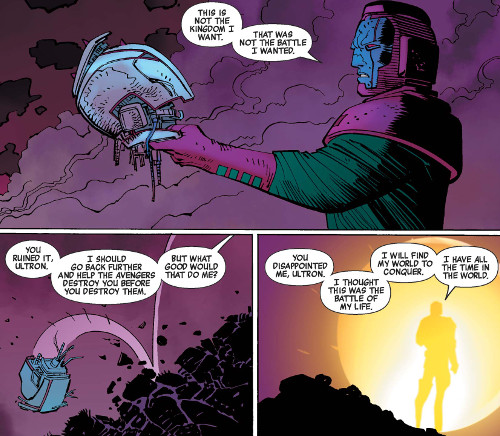 reasoning and, when Kang appeared with his army this time, Ultron went down with minimal effort. Disheartened by the ease of this conquest, Kang dispatched his army back to their appropriate timelines and returned to his dynasty.
reasoning and, when Kang appeared with his army this time, Ultron went down with minimal effort. Disheartened by the ease of this conquest, Kang dispatched his army back to their appropriate timelines and returned to his dynasty.
As the timestream stabilized, the eye of the timestorm left behind time remnants of Kang and the next generation Avengers from the aborted timeline. Kang was spiteful about the "mistreatment" he supposedly received at the hands of the heroes, and he turned on his allies, murdering Stark and Maestro for their disrespect. The next generation Avengers fought back and ultimately killed Kang, ending the line of this version of Kang in the myriad timelines. [Avengers (4th series) #1-6]
[Note: For unexplained reasons, Kang turned into Immortus in the final moments of his encounter with the Avengers Next. Immortus has posed as his past self before, such as The Crossing, but that doesn't appear to be the case here. The easiest explanation is that Kang fluctuated identities as a result of the re-stabilizing timelines in the wake of the universal reset.]
One of the conquests Kang had never been able to achieve was a decisive and lasting victory over mutantkind. The offshoot of humanity had seasoned champions in any age, thanks to the Celestial gardeners and their ascended protectors. The evolutionary caretakers like Apocalypse and the Apocalypse Twins proved to be unbeatable foes in numerous campaigns waged by Kang and his counterparts. And because of the Celestials' orchestrated redundancies, a Deathseed would empower a new caretaker if the existing one ever fell. Kang found that even if he defeated Uriel, his sister Eimin (or Genesis or Genocide) would rise up to become even more powerful in his wake. In his explorations of the timestream, Kang discovered a temporal lock around the era of Uriel and Eimin's birth, preventing him from somehow stopping their conception or birth. And so, Kang decided to play the long game, orchestrating a complicated sequence of events across multiple eras in order to eliminate the Apocalypse Twins and the obstacle of the evolutionary caretakers forevermore.
Mere hours after their birth, Kang arrived at the Akkaba city and removed Uriel and Eimin from their cribs. He brought the twins into his future dynasty to raise them and sculpt them in his image. 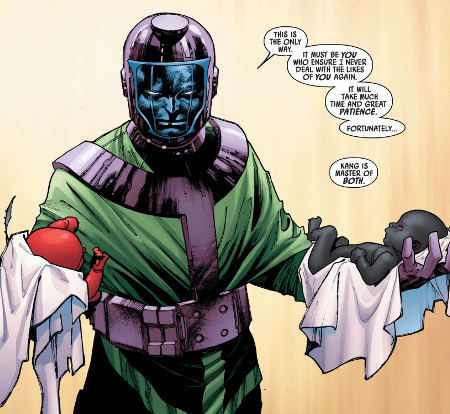 Kang lied to the twins from an early age, glorifying his own accomplishments and claiming to have killed divergent versions of them in one universe after another (when in reality it usually ran the other way). According to Kang, Uriel and Eimin were destined to fail in their role as evolutionary caretakers, that man would always hunt and destroy mutant, but he had taken pity on them and offered a way to save their people: Exodus. Kang drove home the differences between human and mutant by abandoning the twins to the Red Skull and Ahab's mutant concentration camps in the near future of the 21st century whenever they displeased him, stressing over and over that humans would always hate and betray mutants. Kang wanted the twins to orchestrate a mutant "rapture," leading mutantkind to a space ark and colonize a world far from Earth. This would allow mutantkind to live free of prejudice while leaving Earth free of mutants for Kang's inevitable conquest.
Kang lied to the twins from an early age, glorifying his own accomplishments and claiming to have killed divergent versions of them in one universe after another (when in reality it usually ran the other way). According to Kang, Uriel and Eimin were destined to fail in their role as evolutionary caretakers, that man would always hunt and destroy mutant, but he had taken pity on them and offered a way to save their people: Exodus. Kang drove home the differences between human and mutant by abandoning the twins to the Red Skull and Ahab's mutant concentration camps in the near future of the 21st century whenever they displeased him, stressing over and over that humans would always hate and betray mutants. Kang wanted the twins to orchestrate a mutant "rapture," leading mutantkind to a space ark and colonize a world far from Earth. This would allow mutantkind to live free of prejudice while leaving Earth free of mutants for Kang's inevitable conquest.
As part of the same strategy, Kang engineered the creation of an incredible weapon, the Wrecker of Worlds. In 1013 AD, before he proved worthy of Mjolnir, Thor wielded a mighty axe named Jarnbjorn. In his Rama-Tut identity, Kang appeared before his former slave En Sabah Nuhr, now the Apocalypse, to warn him that the Thunder God would one day prove to be a great threat to both their schemes if he wasn't dealt with in this time. Apocalypse attacked the young god and nearly killed him with minimal effort. Beaten and humbled, Thor presented himself before the All-Father, seeking the means of retribution. Odin replied that Apocalypse's Celestial armor was nearly unbreakable, and the pact between the Skyfathers of Earth and the Celestials prevented 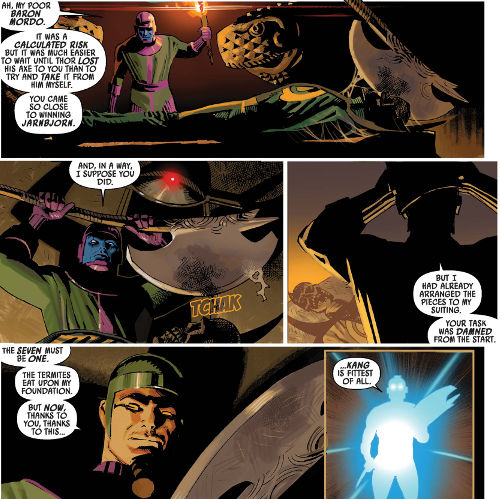 him from taking action against their caretaker. Kang approached Thor while disguised as Loki and led him to a forbidden spell in the archives that could only be cast by one of Odin's bloodline and would make a weapon powerful enough to split Celestial armor. Thor used the spell and made Jarnbjorn such a weapon, driving off Apocalypse during an attack on medieval London. Centuries later, Kang recovered Jarnbjorn for himself after Thor lost it in conflict with Baron Mordo.
him from taking action against their caretaker. Kang approached Thor while disguised as Loki and led him to a forbidden spell in the archives that could only be cast by one of Odin's bloodline and would make a weapon powerful enough to split Celestial armor. Thor used the spell and made Jarnbjorn such a weapon, driving off Apocalypse during an attack on medieval London. Centuries later, Kang recovered Jarnbjorn for himself after Thor lost it in conflict with Baron Mordo.
When Uriel and Eimin came of age, they traveled back in time to fulfill Kang's plans for their destiny, but with a wrinkle of their own: Jarnbjorn. As they prepared for the mutant rapture, the Apocalypse Twins stole Jarnbjorn from Kang's trophy room and murdered a number of Celestials with the axe, drawing the ire of the Space Gods down upon Earth. With the mutants safely ensconced in the space ark, Exitar the Executioner arrived to stand in judgment of the Earth, and pronounced its destruction. Despite the death of Uriel and the efforts of the Avengers Unity Division, mutantkind lived on while humanity died with their planet, centuries before Kang's dynasty came into existence. And thanks to the tachyon dam set up by the Apocalypse Twins in advance, their machinations were locked in place, that era guarded against intrusion or manipulation by time travelers. The point in time where they arranged the destruction of Earth was 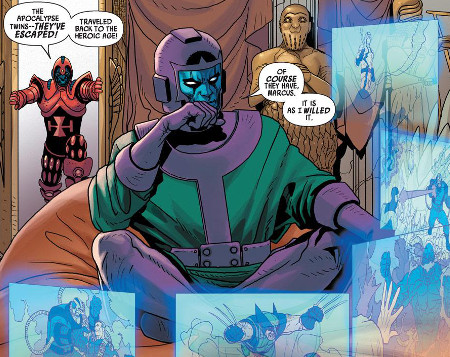 a key era in history, the genesis of the main timeline splitting into seven equally "prime" future timelines, all of which now no longer had an Earth. In the 42nd century, Kang watched as his reality literally unraveled around him.
a key era in history, the genesis of the main timeline splitting into seven equally "prime" future timelines, all of which now no longer had an Earth. In the 42nd century, Kang watched as his reality literally unraveled around him.
In response to the Twins' actions, Kang moved through the seven prime timelines as they disintegrated, recruiting allies for his Chronos Corps. From the near future, he recruited Ahab at the Red Skull's mutant concentration camps in Genosha. In 2020, Arno Stark joined Kang as the Iron Man of his era. In 2033, the daughter of Spider-Man had bonded with the alien symbiote as Venom. In 2043, Magistrate Elisabeth Braddock stepped forward to defend her orderly world. In 2055, the Deathlok-Abomination of Weapon Infinity saw the logic of serving Kang. In 2099, Doom needed allies to rebuild his timeline as well. And in 3086, Stryfe the Chaos-Bringer left behind his Mutant Liberation Front on an orbital habitat to ensure his future.
Kang and the Chronos Corps fled into the new, single prime timeline where Eimin had helped establish Planet X for the castaway mutants of Earth. They entered an alliance with Thor, Havok, and Wasp, the surviving and free members of the Avengers Unity Division, who had finally destroyed the tachyon dam six years after the destruction of Earth, allowing the Chronos Corps to materialize. A plan was concocted to send the surviving Unity members back in time to prevent Earth's destruction. Because the dam was still in place in the hours before Earth's destruction, it was still impossible to physically travel back in time. The Unity members would be transported astrally to possess their past selves, thanks to a combination of Kang, Braddock and Doom 2099's abilities.
Havok was reluctant to trust Kang, despite the Conqueror's self-serving need to restore his lost kingdom. Furthermore, life had continued in the six years since Planet X's formation, and Havok 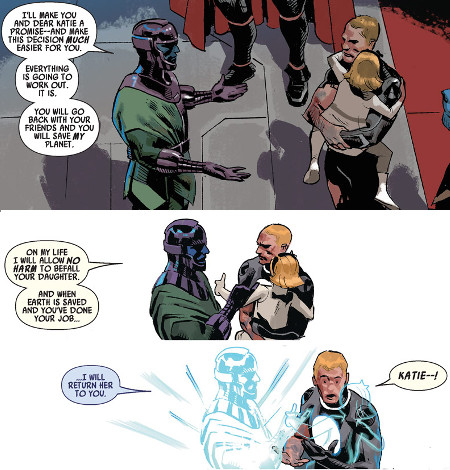 and Wasp had married and conceived a daughter, Katie. As both a carrot and a stick, Kang stole Katie away from Havok, transporting her into the timestream. On the positive side, this meant Katie wouldn't be erased from existence with the rest of the Planet X timeline if they succeeded, but practically speaking it also made her a hostage of Kang's good intentions. With no choice but to proceed, Havok and the Unity Division agreed to Kang's plot. The Chronos Corps dealt with Eimin and her surviving Horsemen of Death to rescue the last two Unity members, Wolverine and Sunfire, before sending them back to the past.
and Wasp had married and conceived a daughter, Katie. As both a carrot and a stick, Kang stole Katie away from Havok, transporting her into the timestream. On the positive side, this meant Katie wouldn't be erased from existence with the rest of the Planet X timeline if they succeeded, but practically speaking it also made her a hostage of Kang's good intentions. With no choice but to proceed, Havok and the Unity Division agreed to Kang's plot. The Chronos Corps dealt with Eimin and her surviving Horsemen of Death to rescue the last two Unity members, Wolverine and Sunfire, before sending them back to the past.
The Avengers Unity Division altered the course of previous events, saving their members who died in the original timeline and destroying the present day tachyon dam. Most of the Avengers were occupied with either defeating the remaining Horsemen of Death or preventing Exitar the Executioner from descending upon the Earth. Thor reclaimed Jarnbjorn and reluctantly used it to cut open Exitar, knowing the Celestials would never listen to how the Twins manipulated them. 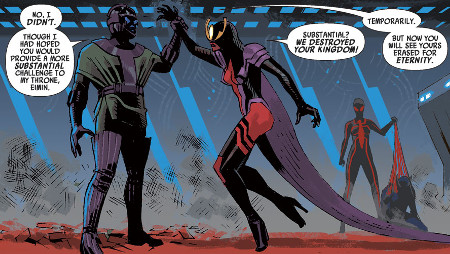 However, as the Celestials' cosmic "blood" poured out of its mortal neck wound and Thor prepared to warp the energy to a distant star system where it would bring new life, Kang arrived. He shoved aside the Thunder God and drank in the full power of the greatest Celestial in existence. Kang's body and armor were fully prepared to harness the Celestial's energies because this had been Kang's plan since the day he stole away Uriel and Eimin from Akkaba.
However, as the Celestials' cosmic "blood" poured out of its mortal neck wound and Thor prepared to warp the energy to a distant star system where it would bring new life, Kang arrived. He shoved aside the Thunder God and drank in the full power of the greatest Celestial in existence. Kang's body and armor were fully prepared to harness the Celestial's energies because this had been Kang's plan since the day he stole away Uriel and Eimin from Akkaba.
Kang's machinations were indeed the riskiest of long games, requiring the utter destruction of his own kingdom just so he could recruit allies who would not only restore that kingdom, but would be unable to stand against his claim for ultimate power without risking their own timelines. Despite what they believed, Kang intended the Apocalypse Twins to steal Jarnbjorn from the beginning. He orchestrated the space ark plot for Uriel and Eimin to carry out, then allowed them to believe the addition of executing the Celestials was their own idea to defeat him. He even seeded the ideas of using Jarnbjorn and wiping out his timeline in Eimin at an early age, without her realizing it. The destruction of Earth allowed him to recruit allies for his Chronos Corps from the seven prime timelines as they died. The Chronos Corps had no choice but to serve Kang so that their timelines would be restored, and Kang's plan to have Thor kill Exitar and prevent the destruction of Earth perfectly positioned all his foes as Kang claimed the power of a Celestial to become the Conqueror of the Universe.
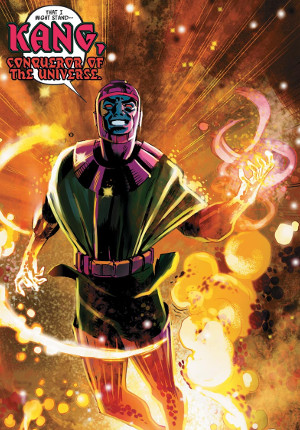 After casting aside Thor, Kang began to drink in the Celestial energy and evolve to god-like levels of power. Havok and Sunfire intervened from shutting down the tachyon dam at the Akkaba Nebula, momentarily dislodging Kang so they could use their own energy-absorbing abilities to absorb the cosmic energy in his place, and receive a fighting chance. Kang recovered and slid an energy blade into Sunfire’s back, causing the atomic samurai to erupt and seemingly die in a cosmic fireball. With only Havok remaining, Kang was confident of his victory. After all, he held the X-Man’s daughter Katie in temporal space, and only through Kang’s good graces would Havok see his daughter again. He demanded Havok stand impotently aside as he reclaimed his power and his empire.
After casting aside Thor, Kang began to drink in the Celestial energy and evolve to god-like levels of power. Havok and Sunfire intervened from shutting down the tachyon dam at the Akkaba Nebula, momentarily dislodging Kang so they could use their own energy-absorbing abilities to absorb the cosmic energy in his place, and receive a fighting chance. Kang recovered and slid an energy blade into Sunfire’s back, causing the atomic samurai to erupt and seemingly die in a cosmic fireball. With only Havok remaining, Kang was confident of his victory. After all, he held the X-Man’s daughter Katie in temporal space, and only through Kang’s good graces would Havok see his daughter again. He demanded Havok stand impotently aside as he reclaimed his power and his empire.
Havok defied all of Kang’s probability scenarios, however, by acknowledging his daughter was already lost to him, just a prize for Kang to dangle before his eye in order to control him. Havok lashed out at Kang, using the accumulated cosmic energies of the Celestial to power his own blasts. Havok battered the conqueror senseless, driving him away from the Celestial energies and diminishing his power. Kang could not stand against Havok’s fury, and was forced to withdrawal, cursing Summers’ name in the process. He vindictively left behind Ahab, one of his Chronos Corps, to help accelerate the Red Skull’s plans to become the Red Onslaught and devastate the mutant population who had overcome his dreams of conquest yet again. [Uncanny Avengers (1st series) #5-22]

In time, the multiverse itself was collapsing, as the Incursions devastated realities like an infinite run of dominos falling into entropy. Kang, or a version of him, found himself paradoxically trapped at the End of Time with Iron Lad and Immortus, his older and younger selves. Captain America passed through their realm, caught in the wake of a shattering Time Gem that pulled him through time. Cap was at odds with Iron Man, Reed Richards and the Illuminati, all of who were working to stop the Incursions collapsing the multiverse. The Trinity of Nathaniel Richards tried sending Cap back in time with a mandate to aid Stark's efforts, as they might be able to save the multiverse, but this gambit failed. The temporally aware trio were able to recognize this and attempted to alter their own actions. The "next" time Cap passed through the End of Time, they trapped the Time Gem in a stasis field of no-time, intending to keep the Captain their prisoner, removing him as a variable for the Illuminati altogether. Cap refused to be caged, and shattered Kang's stasis field, allowing the Time Gem to return him to the present. [Avengers (5th series) #34]
All of existence remained in peril, and so Black Bolt of the Inhumans reached out to Kang to make a devil's bargain. Black Bolt was focused on multiversal triage with the Illuminati, but he was still a father and wanted to save his son Ahura if possible. Kang bargained with Black Bolt, agreeing to hide Ahura in the timestream so that the Inhuman prince survived when Everything Dies, but in exchange Ahura would become his ward forevermore, and Black Bolt would never see his son again. Black Bolt reluctantly accepted this deal, and went on to face the final Incursions knowing that his son was safe. To ensure Ahura had every advantage for what was to come, Black Bolt said goodbye to his son by exposing him to the Terrigen Mists, triggering a Terrigenesis cocoon and Ahura's evolution into a true Inhuman. [Uncanny Inhumans #0]
Kang brought Ahura's cocoon thousands of years back in time to the dawn of the Inhuman age. Ahura's Terrigenesis would be overseen by Randac himself, progenitor of the line and creator of the Terrigen process. Of course, when the universe ultimately survived the Incursions (albeit in a new incarnation), Black Bolt decided he wanted his son back. He and the Orollan Inhuman known as Reader traveled back to Randac's age to retrieve Ahura. Kang sensed their arrival, and declared Black Bolt's intentions a breach of their bargain. He displaced Black Bolt and his team to a Russian nuclear testing site during the Cold War, and they barely escaped thermonuclear detonation.
Declaring himself at war with the Inhumans after this, Kang spent decades training Ahura to fight on the battlegrounds of history, honing his battle skills and his newfound Inhuman powers. Ahura learned quickly, rising from soldier to general to commander of entire campaigns for Kang. These battlegrounds had a second purpose for Kang. The conqueror had charted Inhuman genealogy throughout the ages, and these conquests were designed to eliminate particular ancestors of the various key Inhumans in the 21st century. With each victory in the past, Ahura was wiping out his family and countrymen in the future, until Attilan itself ceased to exist. Ahura was no fool, however, and he knew what Kang was manipulating him into doing. Unfortunately, Kang's cruel tutelage and a lifetime of abandonment by his real family caused Ahura to adopt Kang's cause as his own. He eventually killed his adopted father, taking Kang's armor and kingdom as the spoils of war. Black Bolt's son was as cruel and twisted as Kang intended, but the Conqueror did not live long enough to see Ahura killed by his own parents as a mercy for what he had become.
The Inhumans doubled-back on their own timeline to prevent Ahura from becoming the next Kang, traveling again to Randac's era. In an impressive bit of strategy by Black Bolt, their second time travel back to the same moment masked their arrival from Kang's temporal scanners this time around. Kang's temporal detection did not differentiate the two, separate temporal events happening at the same time. This allowed them to approach Randac and Ahura unnoticed while Kang was dealing with their earlier selves. Medusa had the opportunity to explain to Ahura what Kang twisted his older self into becoming. Kang returned and unleashed the forces of the ages against the Inhumans before taking Ahura hostage. Medusa and Black Bolt could not retrieve Ahura from his captor without hurting him, so Ahura was forced to free himself. Calling upon his new Terrigenesis-given abilities, Ahura cast a psychic double into Kang, controlling the Conqueror. The young prince forced Kang to leave and undo all the damage he had done to the Inhuman timeline. [Uncanny Inhumans #1-4]
Kang's temporal mechanics became complicated when an unexplained "firewall of time" caused him to fragment into various divergent selves. One such fragment was trapped in the 21st century, able to manipulate time around him for various feats, but unable to travel back to his own future 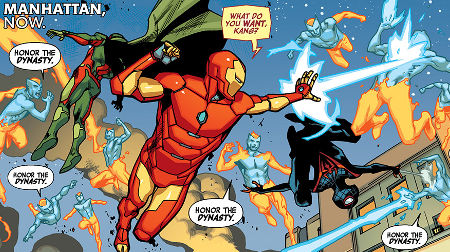 kingdom. Establishing himself in the present as "Mr. Gryphon," Kang took advantage of Iron Man's lack of funding to buy Avengers Tower from Stark. While supervising the purchase, "Gryphon" encountered the Chitauri Warbringer, seeking revenge on Nova. Gryphon directed Warbringer towards assembling the pieces of a Chitauri space-time device to bring an army of alien warriors from the future to attack Earth (and give Kang access to the future once more). Despite Gryphon's interference, Warbringer not only failed to assemble the device properly, his rampage inadvertently triggered the reformation of the Avengers. [All-New, All-Different Avengers #1-3]
kingdom. Establishing himself in the present as "Mr. Gryphon," Kang took advantage of Iron Man's lack of funding to buy Avengers Tower from Stark. While supervising the purchase, "Gryphon" encountered the Chitauri Warbringer, seeking revenge on Nova. Gryphon directed Warbringer towards assembling the pieces of a Chitauri space-time device to bring an army of alien warriors from the future to attack Earth (and give Kang access to the future once more). Despite Gryphon's interference, Warbringer not only failed to assemble the device properly, his rampage inadvertently triggered the reformation of the Avengers. [All-New, All-Different Avengers #1-3]
Looking to establish an advantage over the Avengers, Kang doubled back on the timeline and installed his own programming in the Vision's software during a recent upgrade, turning the 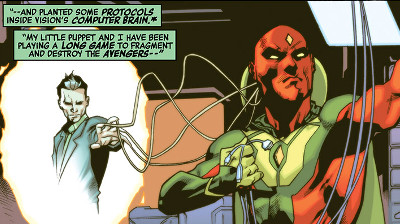 synthezoid into a traitor to the team. While Vision compiled intelligence on his new teammates and arranged them to be compromised, Mr. Gryphon organized several super-criminals such as Equinox, Radioactive Man and Cyclone to strike key targets for his benefit and the rise of the "Qeng Dynasty."
synthezoid into a traitor to the team. While Vision compiled intelligence on his new teammates and arranged them to be compromised, Mr. Gryphon organized several super-criminals such as Equinox, Radioactive Man and Cyclone to strike key targets for his benefit and the rise of the "Qeng Dynasty."
After Vision destabilized the Avengers, Kang made his big move by turning Equinox into an army, folding him back on his own timeline over and over. At Kang's command, Vision turned on the Avengers in the midst of combat, blasting Captain America and Thor through one of Kang's time portals into the near future and separating Thor from Mjolnir in the process. Kang intended to tap into Mjolnir's latent time travel spells in order to return himself to the future. Despite his machinations, however, the Avengers overcame Kang's plot. Iron Man managed to reboot Vision's programming, freeing him from Kang's control. Cap and Thor managed to return from the future by retrieving the future version of Mjolnir to transport them back into the present. Kang was highly vulnerable to temporal paradoxes in his current state, and Thor wielding two versions of the same Mjolnir from different points in its own timeline overwhelmed his temporal stability, casting him out of the timestream. [All-New, All-Different Avengers #4-6]
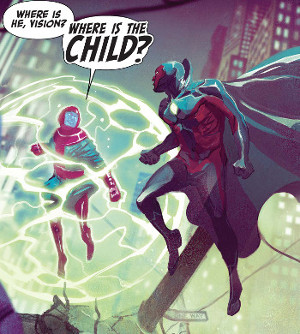 Vision was enraged by Kang's actions and found a way to locate Kang's infant self in the future. He kidnapped young Nathaniel Richards from his crib and left him with the Priests of Pama to be raised as something other than a conqueror. [All-New, All-Different Avengers #13] Kang struggled against the paradox undoing his entire lifeline, and hunted down Vision to find the child and restore his future. In battle with the Avengers, Kang uncontrollably fissioned again to split off his past self, the Scarlet Centurion. Kang and the Centurion together were able to humble the Vision and delay the Avengers long enough to learn Vision had offloaded his memory of the child's whereabouts. As they hunted his memory storage, Kang and the Scarlet Centurion decided to deter further pursuit by traveling back in time and killing the Avengers' current roster when they were infants. [Avengers (6th series) #1]
Vision was enraged by Kang's actions and found a way to locate Kang's infant self in the future. He kidnapped young Nathaniel Richards from his crib and left him with the Priests of Pama to be raised as something other than a conqueror. [All-New, All-Different Avengers #13] Kang struggled against the paradox undoing his entire lifeline, and hunted down Vision to find the child and restore his future. In battle with the Avengers, Kang uncontrollably fissioned again to split off his past self, the Scarlet Centurion. Kang and the Centurion together were able to humble the Vision and delay the Avengers long enough to learn Vision had offloaded his memory of the child's whereabouts. As they hunted his memory storage, Kang and the Scarlet Centurion decided to deter further pursuit by traveling back in time and killing the Avengers' current roster when they were infants. [Avengers (6th series) #1]
Unfortunately for Kang, he had previously fissioned off a benevolent future version of himself, who saw fit to save the Avengers by drawing them into timeless Limbo before the paradox wiped them from existence. And so, one version of Kang began helping the Avengers track two versions of Kang who were hunting a fourth, infant version of Kang. Kang-Prime and the Scarlet Centurion located the Priests of Pama, but were confronted by the immortal Avenger Hercules, whose obscure and unrecorded birth let him avoid their temporal attacks. Hercules had acquired a 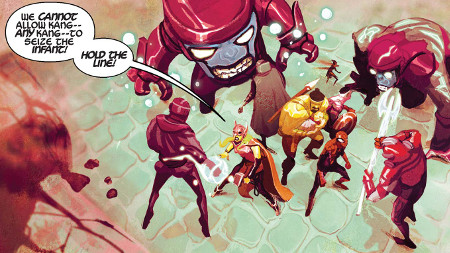 pendant that neutralized the effects of the paradox in his presence, allowing Future-Kang to bring the other Avengers out of Limbo to fight alongside the priests. However, Future-Kang was killed by Kang-Prime almost immediately after leaving Limbo, a further paradox which caused two more malevolent Kang doppelgangers to spawn off from Kang-Prime. Seeing the tide turn against them, Vision counseled the Wasp to take the infant back to the future with Future-Kang's temporal armor, undoing the first paradox which set Kang into motion. [Avengers (6th series) #2]
pendant that neutralized the effects of the paradox in his presence, allowing Future-Kang to bring the other Avengers out of Limbo to fight alongside the priests. However, Future-Kang was killed by Kang-Prime almost immediately after leaving Limbo, a further paradox which caused two more malevolent Kang doppelgangers to spawn off from Kang-Prime. Seeing the tide turn against them, Vision counseled the Wasp to take the infant back to the future with Future-Kang's temporal armor, undoing the first paradox which set Kang into motion. [Avengers (6th series) #2]
Kang and the Scarlet Centurion pursued the Wasp into the timestream until she was pulled ashore in the 26th century by the Priests of Pama. Having acquired temporal powers themselves centuries earlier from exposure to the immense paradox of the infant Kang, the Priests wished to sacrifice baby Kang to the Eternal Flame of Time, ending his threat to all eras and allowing them to feed on his paradoxical energy. Wasp refused to kill the child, but she did enter the flame herself and pull her fellow Avengers through as well, undoing the paradox of Kang killing them as infants. Wasp instead lured Kang and the Centurion to the Priests, allowing them to feed off of the doppelgangers' temporal energy. This left the Avengers free to return the infant to his proper place in time. [Avengers (6th series) #3]
Time travel and time paradoxes are hard to chart, so it's unclear whether Kang-Prime or Scarlet Centurion survived their encounter with the future Priests of Pama. Returning the baby may have undone their fate, or simply another version of Kang continued to live after them. The one true Kang (or not?) now operated from a Citadel at the end of time, orbiting the last dying star, presumably established after the fall of Chronopolis during the Destiny War.
Despite his fortifications, generals and arsenal of anachronistic weaponry, Kang soon found his entire empire crumbling to dust. A Future-Vision from the end of time joined forces with the 21st century Avengers, allowing them to summon two other Avengers rosters from the ages and attack Kang's major outposts and resource hubs throughout the ages simultaneous to each other using a Time Tether. In 2948 B.C., they eliminated the weapons manufacturing site run by Kang's slaves. In 7122 A.D., they stopped alien excavators from harvesting time itself as a resource using temporal tech that literally "stole the future" from races or objects. And in the year 4022, they disabled the earliest incarnation of Kang's future empire before his first encounter with the Avengers.
As his accomplishments and equipment literally faded away before his eyes, Kang was confronted by the assembled Avengers at the end of time. When they moved in to finish him, however, the 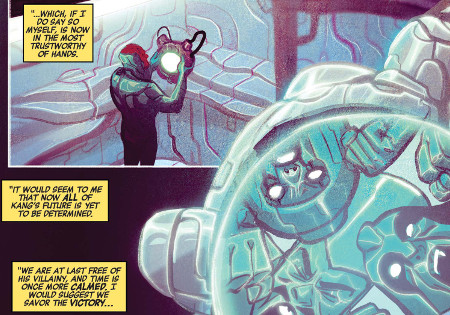 Avengers learned that Kang's timeline was more complicated than they gave it credit for. Immortus, the Scarlet Centurion and even Doctor Doom all appeared before the Avengers to defend Kang, each claiming to be a possible future identity of Kang's. Somehow, still at the height of their individual powers despite Kang being powerless, the future villains began to mow down Earth's Mightiest Heroes in defense of their past self. Salvation only came when the early incarnation of Giant-Man remembered the equipment he recovered from 7122 A.D. Using the future-stealing device, he turned it on Kang and robbed him of his destiny (or destines), restoring the dead Avengers as Immortus and the others ceased to exist. [Avengers (6th series) #4-6]
Avengers learned that Kang's timeline was more complicated than they gave it credit for. Immortus, the Scarlet Centurion and even Doctor Doom all appeared before the Avengers to defend Kang, each claiming to be a possible future identity of Kang's. Somehow, still at the height of their individual powers despite Kang being powerless, the future villains began to mow down Earth's Mightiest Heroes in defense of their past self. Salvation only came when the early incarnation of Giant-Man remembered the equipment he recovered from 7122 A.D. Using the future-stealing device, he turned it on Kang and robbed him of his destiny (or destines), restoring the dead Avengers as Immortus and the others ceased to exist. [Avengers (6th series) #4-6]
With that act, it appears as if Kang has no future. Literally.
